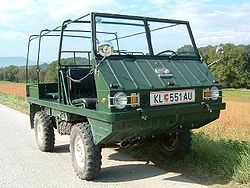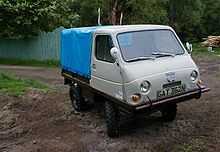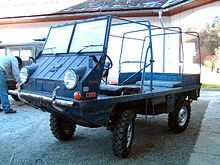Haflinger (vehicle)

The Haflinger is a small, lightweight, four wheel drive, high mobility vehicle about 3.5 m long and 1.5 m wide, powered by a 643 cc twin horizontally opposed, rear mounted, air-cooled engine. Weighing around 600 kg (1322.8 lb), the Haflinger can be lifted by four strong people and yet can carry a load of 500 kg (1102.3 lb). This truck falls into the category of the light utility vehicle.



History
After WWII, the newly organized Austrian Army was equipped with the surplus US Army Willys MB and Ford GPW Jeep. A decade after hostilities ended, the Austrian Army was considering the retirement of the aging Jeeps in favor of something more contemporary as well as locally designed and produced. The design genius of Erich Ledwinka was utilized by the Austrian firm Steyr-Daimler-Puch to produce and field test prototypes. Once the production model design was finalized, the trucks were manufactured between 1959 and 1975 and were exported all over the world. The manufacturer designated the trucks as "Type Multipurpose Passenger Vehicle". A total of 16,647 were made. (See Military Use below.)
The majority of the Haflinger trucks entered directly into the hands of private owners around the world with a small number also being placed into municipal, ambulance and fire brigade services. Just like its predecessor, the US Army Jeep, the Haflinger trucks are at home both off and on road. They have been licensed for on-road use throughout Europe, North and South America, Asia, Africa and Australia. During their 16 year production run, the trucks not only saw domestic sales in Austria but were exported to thirty-five other countries. The first trucks to see use in the United States arrived in 1960. In 1983, a gentleman drove his newly purchased used Haflinger from Vermont back to his home in California. While that is an impressive journey, it pales in comparison to the journey documented by famous Austrian travel journalist Ernst Wiese in his book 10,000 Miles Through Arabia. That work describes his four month long travels from Vienna to the southern tip of the Arabian peninsula and back in his "brave Haflinger". Due to its multi-functional capabilities, many in Europe refer to these vehicles as cars, trucks as well as the "Austrian Jeep". Since August, 2006 there exists a web-project that wants to document the different Haflinger types, the many details and the changes that came with the years of production. See: Haflinger TDC
Military Use
Approximately 7,000 Haflinger were recruited into military service by the Swiss, Austrian and Australian armies and the Royal Navy.
In Australian Army service the 46 Haflinger vehicles were each equipped with a dedicated trailer unit.[1] Haflinger were often allocated to RAEME units where typically an individual craftsman, like artillery artificers, would use the vehicle to carry tools and other equipment around the field attending to technical servicing of weapons platforms and fighting vehicles.
Unfortunately no photographic or documentary evidence currently exists to confirm the rumour that some of the Australian Army trucks saw service in Vietnam during that conflict.[2][3] It is thought that this misconception may have occurred because of the US use of the M274 Mechanical Mule which has a similar size and mechanical arrangement. The M274 did serve in theatre and was used to carry munitions and other equipment.
Features
Particular features that add to the off-road capability include:
- Exceptionally low centre of gravity due to the low placement of the chassis and the lack of upper bodywork
- Generous approach and departure angles
- The provision of both front and rear differential locks enables the vehicle to make progress even if only one wheel is in firm contact with the ground.
- The 'portal' type design of the front and rear axles means that the centre of the axle is above the centre of the wheel, thus increasing ground clearance under the axle without the need to increase the wheel diameter. Power is transmitted from the axle to the wheel via drop gears in each wheel hub.
- The suspension is fully independent, each half-axle having about 25 cm of free movement.
Haflinger Fans
Most enthusiasts are found in Germany and Austria, where there are thriving clubs. There are also many owners/enthusiasts in the UK, USA, Canada, Australia, and Asia. One of the more important club meetings is held every year at the village of Hafling (Avelengo) in Italy.
Design
Haflingers feature in the 1971 Doctor Who story Colony in Space, the location filming for which took place in a clay pit in Cornwall.
Steyr subsequently designed and produced a much larger vehicle of very similar layout to the Haflinger, called the Pinzgauer, which is available in both 4x4 and 6x6 versions.
The name originates from a horse breed of the same name.
Steyr Puch stood alone and had no input from the Daimler-Benz, i.e. Mercedes-Benz, until well after the production of Haflinger ceased.
Steyr Puch was an important light motorcycle manufacturer.
Their expertise in 4WD attracted Mercedes-Benz and they built the first G Wagens (Geländewagen) that were intended as an alternative to the military specification Land Rover. When Mercedes invested in Steyr Puch they started building both Puch and Mercedes badged vehicles.
G Wagens serve in the French Army albeit with Peugeot engines. Under Australian Department of Defence project Land 121 Mercedes-Benz G-Class have been introduced into Australian Army service to replace the ageing Land Rover Perentie[4]
Note: The term 'G-Wagen' is only used in English-speaking parts of the world. It is originally called 'G-Klasse' ('G-Class'), similar to the C-, E-, M-, R-, and S-Klasse in MB's nomenclature.
Also the links with Fiat were maintained as Steyr Puch made all the 4WD kit for the Panda and may still do to this day.
Variants
The Haflinger changed very little during its years of production, but there are some notable changes and variants along the way:
- Series 1: original model, 4-speed gearbox
- Series 2: 5-speed gearbox (Krawler gear) and a higher output motor
- Polycab: upper steel bodywork optionally replaced with a fully enclosed fibreglass cab
- SchneeWiesel: "Snow Weasel" with tires replaced by tracks for snow/ice operations
- Swiss Military: Series1/2 hybrid with unique bumpers, canvas, and other details
- USA-spec: Larger "bugeye" headlights, other modifications to meet US requirements
References
- ↑ REMLR Army Registration Number list http://www.remlr.com/ARN/ARNs_haflinger.php
- ↑ Searching the AWM for conflict="Vietnam" and "Haflinger" produces no results. http://www.awm.gov.au/search/collections/
- ↑ Haflinger, Steyr Puch, does not exist in the table of Australian Army vehicles in Vietnam within the M Cecil/AWM book Mud & Dust http://www.awm.gov.au/shop/item/9781741107678/#.UT3oWzccOSo
- ↑ Project Land 121 press release G Wagon enters Australian Army service http://www.defence.gov.au/dmo/lsd/land121/
External links
| Wikimedia Commons has media related to Steyr-Puch Haflinger. |
- Yahoo Group discussion forum for Haflinger owners
- SchneeWiesel information site
- Haflinger Information site
- plenty of pics
- British club
- French club
- Italian club
- Zuri-Oberland club
- Swiss club
- Sudtiroler club
- North American club
See also
- AMC M422 'Mighty Mite'
- Pinzgauer
- LuAZ-967